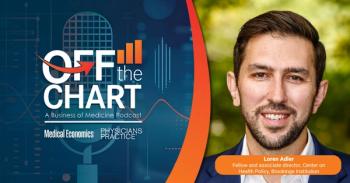
Trendspotter: What If All Payers Paid Medicare Rates?
In the current economic environment, physicians across the country may soon be facing pressure - not only from Medicare, but also from commercial payers - to lower their incomes substantially.
Ask physicians about reimbursement, and most of them will mention that Medicare doesn’t pay enough to cover their costs. But Robert Berenson, MD, a senior fellow at the Urban Institute and vice chair of the Medicare Payment Advisory Commission (MedPAC), points out in
In recent years, doctors and their associations have placed a priority on reversing planned Medicare fee cuts. But while Congress is still
dithering over a bill
that would delay those reductions for 1.5 years, its repeated refusal to approve them in past years suggests that it will not impose them now. The main question about Medicare reimbursement is whether it will continue to be based on an infeasible formula or whether Medicare will switch to a new model. Judging by discussions about payment bundling and accountable care organizations, that model, if it comes to fruition, is likely to include budgets for patient care. And that would mean lower average Medicare reimbursement. Meanwhile, physicians and hospitals continue to shift some of what they view as shortfalls in Medicare and Medicaid payments to private payers. While providers’ market power varies from one region to another, commercial insurers and self-insured employers pay them nearly a third more, on average,
than Medicare does
. But that may not last for long. In Massachusetts, for example,
private insurers have told
hospitals and physician groups that they want to reopen their contracts and reduce the payment increases they’d earlier negotiated. Blue Cross Blue Shield of Massachusetts, which supplies the majority of commercial business to many practices, has said it will cut the reimbursement of providers it regards as highly paid. Blue Cross plans to lower its payments to some hospitals by up to 10 percent, and Harvard Pilgrim says it will freeze or slightly cut payments to 25 of its biggest hospitals and physician groups. The Massachusetts insurers are taking this hard line because the state government has limited the amount by which they can raise rates on small firms and individuals. At the same time, Massachusetts Governor Deval Patrick
has said
he wants some providers to roll back their prices, as well, to help control rapidly rising costs that threaten to make healthcare unaffordable. What would happen if all third-party payers adopted the Medicare fee schedule and if doctors could charge self-paying patients no more than that?
MedPAC
recently sponsored a study on that very question. By applying the Medicare fee schedule to MGMA’s relative-value-unit (RVU) data on physician groups, the MedPAC researchers simulated the results of an all-payer Medicare fee schedule. What they calculated, among other things, is that physicians would earn an average of $240,000 a year, compared with $273,000 today; cardiologists would make $450,000, down from $483,000; and radiologists would take home $390,000, versus $488,000 today. Bear in mind that this annual compensation includes Medicare, and the percentage of practice volume derived from Medicare varies widely, by specialty, geographical region, and physician. Thus, for example, a large portion of cardiologists’ revenue comes from treating seniors; so, naturally, applying Medicare rates to their full book of business reduces their practice income only slightly. In contrast, family physicians treat patients of all ages, so applying Medicare rates to their business cuts their revenue by 10.6 percent. The hardest-hit branches of medicine would be surgery, down an average of 18.6 percent, and radiology, down 20.2 percent. Another point to remember is that if Medicare rates were applied across the board, Medicaid rates would rise. So practices with a lot of Medicaid patients would actually see their revenues increase. That would fit well with a provision of the
health reform legislation
, which will raise primary-care doctors’ fees for treating Medicaid patients to Medicare levels in 2013 and 2014. The key take-home lesson of the MedPAC study is that applying Medicare fees across the board would be painful for some physicians but would barely ding others. Moreover, considering how much some doctors earn today, it would be hard for medical societies to muster much sympathy for them in a population that has been savaged by the recession. So if other state governments follow Massachusetts’ example and hold the line on insurance rate increases, get ready for intense public pressure on physicians and hospitals to accept lower payments.
Newsletter
Optimize your practice with the Physicians Practice newsletter, offering management pearls, leadership tips, and business strategies tailored for practice administrators and physicians of any specialty.









